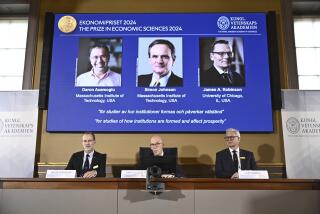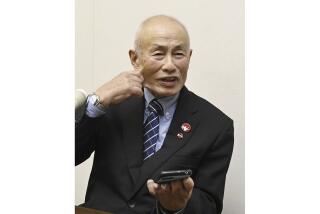La Jolla Surfer Among Nobel Science Winners
Kary B. Mullis, an intellectual maverick who surfs La Jolla beaches at sunrise and skates on Rollerblades every night, was awarded the Nobel Prize in chemistry Wednesday along with Michael Smith of Vancouver, Canada, for fundamental breakthroughs in genetics. The Nobel Prize in physics went to two Princeton University researchers for their discovery of a pulsar that helped prove Einstein’s theory of relativity.
Mullis, 48, an independent biology researcher in La Jolla, was honored for inventing a fast, accurate way of replicating genetic material. The technique, called PCR, has allowed scientists to find genes for major diseases, trace the evolution of humankind, recover DNA from fossil remains and even free innocent people from jail.
Mullis, who says he is not “a regular scientist,” once proposed the sale of celebrity DNA. He said he was elated by the award, but he saw no reason to vary his morning routine. He grabbed his board and went surfing.
“I was excited, happy, exhilarated, so I did what I usually do in the morning,” he said. “I went out on the waves.”
Smith, 61, a director of the Biotechnology Laboratory at the University of British Columbia in Vancouver, won for his discovery, conceived during a coffee break, of a way to alter DNA molecules to learn their functions and then reprogram them to perform differently.
The technique, called site-directed mutagenesis, allows scientists to genetically engineer human proteins, with wide applications in medicine and basic research.
“This should allow us to understand how inherited genetic diseases work, like cystic fibrosis and muscular dystrophy, or non-inherited genetic diseases like cancer,” Smith said Wednesday.
The physics prize was shared by Russell A. Hulse, 42, and Joseph H. Taylor Jr., 53, for the discovery of a rare pair of very small, rapidly spinning stars in 1974, which, the Swedish Academy said, has opened up new possibilities for the study of gravitation.
The binary pulsar they discovered is a “revolutionary space laboratory” that can be used to test theories like that proposed by Albert Einstein.
“So far, Einstein’s theory of gravity has passed the tests with flying colors,” the academy said in its citation.
Taylor said the 1974 discovery has developed into a project that is lasting a lifetime. The project “rewards patience,” he said. “The interesting effects that we are trying to measure accumulate gradually.”
At the time of the discovery Taylor was a professor at the University of Massachusetts at Amherst and Hulse was his student. Hulse received his doctorate in physics from the Massachusetts Institute of Technology one year after they found the binary pulsar.
“One follows one’s nose and follows up on interesting leads as best you can,” Taylor said Wednesday. “This is an illustration of how remarkable physics and science can be. You go into it to find out what makes the world work. This is one such discovery when you get something beautiful and abstract about how it works.”
On Wednesday, Mullis said he figured he would win the Nobel Prize sooner or later, given the prizes and honors he has already received.
“It’s something that I half-expected for some time,” he said. “Now, I’m like, whew, look at that. It’s done. It’s a nice feeling.”
What many scientists believe is the biggest recent advance in molecular biology was not made in a laboratory, but while Mullis was riding his motorcycle a decade ago along California 1 from San Francisco to Mendocino. The idea simply came to him, he said, and he pulled over to mull its implications. “I do my best thinking while driving,” he said.
At that time, Mullis was employed by Cetus Corp., a Northern California research firm, which later sold the patent for $300 million. PCR has become the foundation of what analysts say is a $1-billion-a-year industry.
Mullis got a $10,000 bonus for his discovery and moved to San Diego, where he lives in a small apartment across from Windansea Beach, a surfing spot made famous by Tom Wolfe’s “The Pump House Gang.”
Mullis has stubbornly refused to join the high-pressure world of biotechnology business or academia, preferring instead to do lecturing and consulting and dabble in fields such as cosmology, mysticism, mathematics, virology and artificial intelligence.
“I’m not a regular scientist,” he said.
Born in South Carolina, he received a degree in chemistry from Georgia Tech and a doctorate in biochemistry from UC Berkeley. His doctoral thesis, “The Cosmological Significance of Time Reversal,” argued that the universe is a balance between matter that is shrinking and matter that is expanding. Thrice divorced, he has three children.
He delights in holding contrarian opinions. He is intrigued by astrology and sometimes feels he is psychic. “Now and then I can tell what sign someone is or tell them things about themselves,” he said.
Mullis said he is writing a book about the two-year court fight between DuPont Co. and Cetus over rights to his discovery. After that, he may try science fiction or an autobiography.
Except for making him financially comfortable, Mullis said he did not think the Nobel Prize would change his life or work.
Last spring he won the $450,000 Japan Prize for his discovery, and his half of the $825,000 that accompanies the Nobel Prize comes with no strings and no restrictions.
“It’s your money,” he said. “Candy money. Surfer money. You can blow the whole thing in Amsterdam on the way home.”
Taylor expressed a different perspective on the Prize. He said he was aware of the burden the Nobel Prize sometimes imposes on active scientists, who can find themselves unable to continue creative research. Either they find themselves overwhelmed by speaking invitations or simply discover the prize has quenched their ambition.
“I’m sure it will be a problem and I will work to make sure it is not an insurmountable problem,” Taylor said.
Hotz reported from Los Angeles and Perry from San Diego.
Chain Reaction
Kary B. Mullis and Michael Smith won the 1993 Nobel Prize in chemistry for breakthroughs in genetics, including Mullis’s recipe for a genetic chain reaction called PCR which allows scientists to duplicate and analyze the most minute fragments of DNA.
The PCR Process
1. The orginal DNA is mixed with a primer--a short strand of DNA--that tags it, an enzyme (polymerase) which promotes replication of genes, and nucleotides, which serve as the raw material.
2. The polymerase is heated, triggering the formation of new strands of DNA in a process that can be repeated over and over again. Twenty-five cycles yield about a million-fold increase.
Physics Discovery
The work of Joseph H. Taylor, a Princeton University physics professor, and Russell A. Hulse, a research physicist at the Princeton Plasma Physics Laboratory, earned them the 1993 Nobel Prize in physics:
* The discovery: A new type of pulsing star system called a binary pulsar, in which two dying stars orbit faster and faster around each other in an increasingly tight orbit.
* When: The binary pulsar was found in 1974 with the 984-foot radiotelescope at Arecibo, Puerto Rico.
* The importance: The behavior of the paired stars opens a unique opportunity for the study of gravitation and provides the most precise test yet of Einstein’s general theory of relativity.






